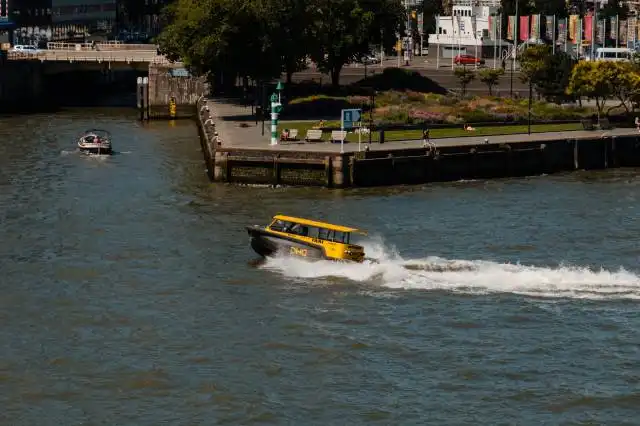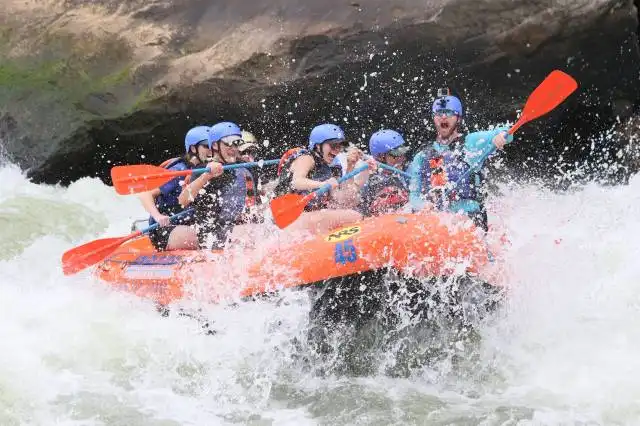Start a Submarine Tour Business
Venture into the Deep: Unveiling the Mysteries of Maritime Tourism
| Updated


SUBMARINE TOUR BUSINESS
Dive into the exciting world of maritime tourism by launching a Submarine Tour Business! Timid beach goers and thrill-seekers alike will be enticed by the opportunity to explore the underwater world without getting soggy. A submarine tour business offers guided deep-sea expeditions, providing a unique glimpse into marine life while also narrating nautical tales. As Jacques Cousteau might say, there's certainly plenty of 'fathomable' fun in this wet and wild venture.
Jump to Business Plan
RELATED BUSINESS IDEAS
Browse ALL Hospitality & Leisure Ventures Business Ideas
Discover Your Perfect Domain
Unlock the door to your online success with our hand-picked selection of premium domain names. Whether you're starting a new venture or rebranding an existing one, the right domain can set the tone for your digital presence. Browse through our curated list, each with its unique potential to enhance your brand's visibility and credibility.
SUBMARINE TOUR MINI BUSINESS PLAN
This a quick reality check to help you identify the strengths and weaknesses of your business concept before you dive in.
Expected Percent Margin:
- Gross Margin: 30-40%
- Net Profit Margin: 10-15%
Earnings Expectations:
- Daily Earnings: $500 - $1,000
- Weekly Earnings: $3,500 - $7,000
- Monthly Earnings: $14,000 - $28,000
- Annual Earnings: $168,000 - $336,000
Actions to Hit Those Numbers:
Initial Investment:
- A tourist submarine cost can vary extensively depending on size and features, but expect to pay anywhere between $1.5m-$3m.
Staffing:
- Hire 3-4 specially-trained submarine operators for rotating shifts. Remember, their salary is a part of your daily operating costs.
Marketing and Customer Acquisition:
- Maintain an active online presence, especially on social media and travel/tourism sites. Posting regularly can engage potential customers and make them want to experience your service.
- Collaborate with local hotels and travel agencies; this ensures a constant inflow of customers.
Tour Pricing:
- Pricing can vary widely based on location, duration, and experience provided. A common range is $50-$100 per person, per trip.
Daily Operations:
- Ensure you run at least two trips per day to maintain steady earnings.
Safety and Maintenance
- Regular maintenance of your submarine is vital for the safety of your customers and longevity of your investment.
- Insurance: Consider comprehensive insurance coverage for unexpected events.
Remember that this outline is for guidance and the actual numbers may change largely depending on your location, the submarine type, local regulations and the tourism industry in your area. Consulting with a business advisor could provide more precise insights.
NOT WHAT YOU HAD IN MIND? Here are more ideas



Browse ALL Hospitality & Leisure Ventures Business Ideas
Grab Your Business Website Name
Before you get caught up in the whirlwind of setting up your business, invest in a domain name. It's a small but significant step that lays the foundation for your brand and makes it easier for customers to find and trust you. Just like you wouldn't build a house without securing the land first, don't build a business without securing your domain name.
"Why? Can't that wait?" Here's why it shouldn't
Step 1: Determine if a Submarine Tour Business is Right for You
Breakdown of Startup Expenses
When considering starting a submarine tour business, it is important to understand the startup expenses that will be required. These expenses can include the cost of the submarine itself, the cost of any necessary permits, the cost of any necessary equipment, and the cost of any necessary training. Additionally, the cost of marketing and advertising should be taken into consideration. It is important to understand all of these expenses before beginning the business in order to ensure that the business is financially feasible.
Breakdown of Ongoing Expenses
In addition to the startup expenses, it is important to understand the ongoing expenses that will be required to keep the business running. These expenses can include the cost of fuel, the cost of maintenance, the cost of insurance, and the cost of any necessary repairs. Additionally, the cost of marketing and advertising should be taken into consideration. It is important to understand all of these expenses before beginning the business in order to ensure that the business is financially feasible.
Examples of Ways to Make Money
When considering starting a submarine tour business, it is important to understand the ways in which money can be made. These can include charging customers for tours, charging customers for souvenirs, charging customers for photos, and charging customers for additional services. Additionally, it may be possible to partner with other businesses in order to make money. It is important to understand all of these ways to make money before beginning the business in order to ensure that the business is financially feasible.
Step 2: Name the Business
Naming a business is an important step in the process of starting a submarine tour business. It is important to choose a name that reflects the business’s mission and goals. It should also be memorable and easy to pronounce. Consider using a combination of words or phrases that are related to the business or its services. For example, if the business is based in a coastal town, consider using a combination of words that evoke the ocean, such as “Sea Voyage Tours” or “Deep Sea Adventures.” Additionally, research the name to make sure it is not already in use by another business. It is also important to check with the local government to make sure the name is not already trademarked. Finally, consider registering the business name with the local government to protect it from being used by another business.
Step 3: Obtain the Necessary Licenses and Permits
Before starting a submarine tour business, it is important to obtain the necessary licenses and permits. Depending on the location of the business, this could include a business license, a sales tax permit, and a permit to operate a commercial vessel. It is also important to check with the local government to ensure that the business is in compliance with all local laws and regulations. Additionally, it is important to obtain any necessary insurance policies, such as liability insurance and workers' compensation insurance. Finally, it is important to research any additional permits or licenses that may be required in order to operate a submarine tour business.
Step 4: Secure a Location
Once the business plan is complete, the next step is to secure a location for the submarine tour business. This could be a dock, a marina, or a beach. It is important to consider the local regulations and zoning laws when selecting a location. Additionally, the location should be easily accessible to customers, and have enough space to accommodate the submarine and other necessary equipment. It is also important to consider the cost of renting or leasing the location. This could include the cost of any necessary renovations or repairs. Additionally, the location should have the necessary utilities, such as electricity, water, and sewer. Finally, the location should have enough parking to accommodate customers and employees.
Step 5: Purchase the Necessary Equipment
Once the business is legally established, it is time to purchase the necessary equipment for the submarine tour business. This includes the submarine itself, which can range from a small, two-person submarine to a larger, more luxurious model. It is important to research the different models and determine which one best fits the needs of the business. Additionally, the business will need to purchase the necessary safety equipment, such as life jackets, oxygen tanks, and communication devices. It is also important to purchase a GPS system, so that the submarine can be tracked and monitored at all times. Finally, the business should also purchase any additional equipment that may be necessary for the tours, such as underwater cameras, lights, and other tools.
Step 6: Create a Business Plan
Creating a business plan is an important step in starting a submarine tour business. A business plan will help you to organize your thoughts, create a budget, and determine the feasibility of your business. It should include a description of the business, a market analysis, a competitive analysis, a marketing plan, an operational plan, and a financial plan. The business plan should also include a mission statement, a description of the services you plan to offer, and a description of the target market. Additionally, it should include a detailed budget for startup costs and ongoing expenses, as well as a timeline for when you expect to break even and start making a profit.
Step 7: Obtain Funding
Once you have created a business plan, you will need to obtain funding for your submarine tour business. There are several options for funding, including personal savings, loans from family and friends, bank loans, and venture capital. You should research each option and determine which one is best for your business. Additionally, you may want to consider applying for grants or other forms of government funding.
Step 8: Market Your Business
Marketing is essential for any business, and a submarine tour business is no exception. You should create a marketing plan that outlines the strategies you will use to reach your target market. This should include a combination of online and offline marketing tactics, such as creating a website, using social media, running ads, and attending trade shows and industry events. Additionally, you should consider offering discounts or other incentives to attract customers.
Step 9: Hire Employees
The final step in starting a submarine tour business is to hire employees. You should create job descriptions for each position and post them on job boards and other websites. Additionally, you should consider using a recruitment agency to help you find qualified candidates. Once you have found the right employees, you should provide them with the necessary training and resources to ensure they have the skills and knowledge needed to do their job.
Step 7: Market the Business
Once the business is up and running, it is important to market it in order to draw in customers. There are many ways to market a business, including traditional advertising, online marketing, and word of mouth. Traditional advertising can include print ads, radio ads, and television ads. Online marketing can include creating a website, using social media, and creating email campaigns. Word of mouth can be the most effective form of marketing, as people are more likely to trust the recommendations of friends and family. It is important to create a marketing plan that outlines the goals of the business and the strategies that will be used to reach those goals. Additionally, it is important to track the success of the marketing efforts in order to make adjustments as needed.
Step 8: Hire Employees
Before hiring employees, it is important to determine the number of employees needed and the type of employees that are necessary for the business to run smoothly. It is also important to create a job description for each position that outlines the duties, qualifications, and expectations of the job. Additionally, it is important to decide on the salary and benefits that will be offered to employees. Once the job descriptions are created, it is important to post the job openings in various places, such as job boards, newspapers, and online job sites. It is also important to interview potential employees and to check references to ensure that the best candidates are hired. Additionally, it is important to provide training to new employees so that they are able to perform their duties in a safe and efficient manner. Finally, it is important to provide ongoing training and support to employees to ensure that the business is running smoothly.
Step 9: Open the Business
The ninth and final step in starting a submarine tour business is to open the business. This involves obtaining the necessary permits and licenses, hiring staff, and launching the business. Depending on the type of business, it may be necessary to obtain a business license or a permit from the local government. Additionally, it may be necessary to obtain a special permit from the local harbor authority or the Coast Guard.
Once the necessary permits and licenses have been obtained, it is time to hire staff. This includes hiring a captain, crew, and tour guides. It is important to hire experienced and knowledgeable staff who are familiar with the local area and the type of tours being offered. Additionally, it is important to ensure that all staff members are properly trained and certified.
The next step is to launch the business. This involves advertising the business, setting up a website, and creating a marketing plan. Additionally, it is important to create a pricing structure that is competitive and attractive to potential customers.
Finally, it is important to create a customer service plan. This includes setting up a customer service hotline, responding to customer inquiries and complaints in a timely manner, and ensuring that customer satisfaction is a top priority. Additionally, it is important to create a system for tracking customer feedback and using it to improve the business. With the right plan in place, the business should be ready to open and start taking customers.
EXPLORE MORE CATEGORIES
Browse ALL Business Idea Categories
TAKE THE NEXT STEPS










